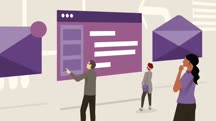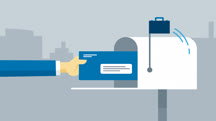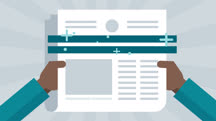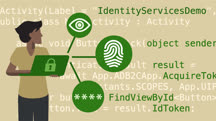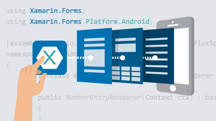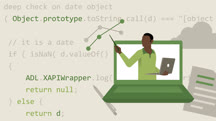Course catalog
Categories
Showing 8,821-8,840 of 8,871 items.
Writing Email
Discover the secrets to writing powerful emails.
Writing Emails People Want to Read (225876)
In this course, instructor Sam Bennett shows you how to write great emails that'll leave a positive impression. First, Sam explains that being both personal and direct contributes to a high ROI, no matter who your recipient is. She goes over how to utilize the basic types of emails: inquiry, transactional or informational, and marketing or sales. She steps you through how to write engaging yet clear emails that grab your customer's attention and keep it. Sam teaches you what makes a good story work and what will convert prospects to customers. She walks you through best practices to make sure your emails get read at the right time by the right people and how to craft a relevant call to action. She shows you how you can reuse emails as blog posts, social media posts, and even compiled as ebooks. Sam concludes by discussing how to leverage email content to improve your FAQ and About US pages.
This course was created by Madecraft. We are pleased to host this training in our library.

This course was created by Madecraft. We are pleased to host this training in our library.

Writing Formal Business Letters and Emails
Learn how to write formal business letters and emails that are short, clear, and to the point.
Writing Headlines
Learn how to write a headline that conveys an exciting, accurate, and irresistible sense of your story. Hone your skills with headline writing tools, tips, and real-world examples.
Writing in Plain English
Learn to write in a way that is easily understood by your target audience: clear and straightforward, appropriate to their reading level, and free of wordiness, clichés, and jargon.
Writing in Plain Language
Learn to write in plain language and help your readers understand and act on your documents and content.
Writing Speeches
Learn how to write, organize, and deliver the perfect speech.
Writing to be Heard on LinkedIn
Get practical advice on how to write great posts and create conversations around your ideas on LinkedIn.
Writing Under a Deadline
Learn how to produce a well-written piece in whatever time you've got. Discover how to negotiate your assignment, plot your timeline, organize your message, and dial in your focus.
Writing White Papers (142899)
White papers were originally produced by governments, but now serve a vital purpose in marketing departments worldwide. A white paper is a deep dive into a concept, initiative, or product, designed to educate and persuade by framing issues in a clear way. In this course, corporate communications pro Tom Geller leads you through the format, purposes, and uses of white papers; helps you define what you want your paper to be; and then helps you make it a reality. You'll finish this course with information about where white papers fit in the greater business ecosystem—and how to make your paper the best it can be.
Writing with Commonly Confused Words (216951)
Have you ever had to cite a sight you saw while on site? English has many troublesome words that people commonly confuse, which can lead to misunderstandings, confusion, and embarrassment. Using the wrong word can affect your credibility and have an adverse effect on communication. In this course, Mignon Fogarty, better known as Grammar Girl, covers some of the most frequently misused words, from words that sound the same, like “compliment” and “complement,” to words with commonly misunderstood meanings, like “farther” and “further.” Learn how to write with more confidence, make fewer mistakes, and spend less time doubting how to use these tricky words.
Writing with Flair: How to Become an Exceptional Writer
Learn practical tips to improve your writing. Explore the mindset of an elite writer and learn what top wordsmiths do to keep their writing purposeful, concise, and a joy to read.
Writing with Impact
Learn how to write anything with maximum impact. Get tips for making your writing concise, clear, and right for its specific purpose.
Writing with Proper Punctuation (217410)
Help your readers understand your writing easily and fully by leveraging the basics of good punctuation. In this course, instructor Mignon Fogarty, better known as Grammar Girl, shows you how. First, she introduces the apostrophe and how it is used to show ownership, make contractions, and occasionally form plurals. Next, Mignon dives into the many uses of commas, including after an introductory element, between different clauses, and as a serial comma. Learn how to use hyphens in compound modifiers, with prefixes, and as a suspensive hyphen. Find out how to use question marks in different types of questions. Explore how to use quotation marks with commas and periods, as well as with other punctuation marks. After this, Mignon walks you through using semicolons to join main clauses and in complicated lists. She also covers parentheses, abbreviations, asterisks, colons, and dashes, and more.
Writing: The Craft of Story
Dig into the craft of writing a compelling story, with practical how-to advice and before-and-after writing samples.
X-Particles 4 for Cinema 4D Essential Training
Get started with X-Particles 4, the powerful Cinema 4D plugin that allows artists to quickly and easily create finely rendered fluid simulations, dynamics, and collisions.
Xamarin Development: Authentication and Identity
Learn how to use the Xamarin.Auth library to authenticate mobile users and restrict or allow access to resources and functionality in your C# applications.
Xamarin Essential Training: Create Your First App
Learn how to use Xamarin to develop your first cross-platform application, for mobile devices running Android or iOS.
Xamarin.Forms Essential Training
Get started with Xamarin.Forms. Learn how to use this cross-platform UI toolkit to build fully native mobile apps using C#.
xAPI Foundations
Use the Experience API (xAPI) to monitor the effectiveness of online training. Learn how to use xAPI to generate insights on learning outcomes and student engagement.

